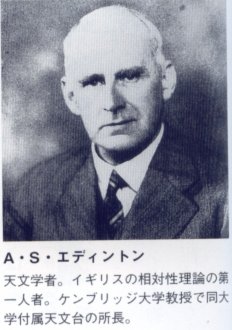
A. エディントン(Sir Arthur Stanley Eddington, 1882-1944:英国の天文学者)は,原子の自由 -それ(注:原子の行動は全て決まっているわけではないこと)を事実と仮定して- から情緒的に受け入れることができる結論に到達するために,彼自身認めているように,現在でもまったくの仮説に過ぎない想定をすることを余儀なくされた。彼は人間の自由意志(人間に自由意志があること)を守りたいと望んでおり -自由意志が何らかの重要性を持つとしたら- 自由意志は大規模な物体を扱う力学(large-scale mechanics (注:古典力学の中の大規模な物体を扱う部分)の法則から生ずる運動以上の大規模な身体運動(活動)を引き起こす力を持たなければならない。ところで,既に考察したように,大規模な物体を扱う力学の法則は,原子に関する新しい理論(注:量子力学)によって変更される(変更を受ける)ことはない。(即ち)唯一の相違は,(現在の)大規模力学は(従来の)確実性(の断定)のかわりに,非常に高い確率があること(overwhelming probabilities)を述べるという点である(注:大規模な物体については古典力学の法則が今でも通用するが,現代物理学からみればその法則は絶対確実なものではなく、非常に確率が高いと言うべきである、といった趣旨/ちなみに,荒地出版社刊の津田訳では,「they now state」の「they」を新理論(量子力学)として「唯一のちがいは,新理論が今日,確実性についてよりも強度の蓋然性について語る点である」と訳している。一見間違ってないように見えるかも知れない。しかし「they」は直前の文の主語「the laws of large-scale mechanics」ととるのが素直であろう。即ち,「大規模な物体を扱う力学は、量子力学出現前後で変化はなく、ただ違いは・・・にある」と解釈すべきであろう)。非常に小さな力が非常に大きな効果(effect 影響)を及ぼすかも知れないがゆえに(可能性があるために),これらの法則の確率(蓋然性)はある種特有の不安定性によって打ち消されると想像することも可能である。エディントンはこのような不安定性が生体(living matter)に,特に脳の中に,存在するかも知れないと想像することは可能である。(注:このあたりは,人間と言えども原子の集合体であることを念頭に読む必要がある。)意志(による)行為がひとつの原子をあの選択ではなくこの選択へと導き,そのことがあるとてもデリケートなバランスをひっくりかえし,そうして,別のことではなくあることを言う(語る)というような大規模な結果を引き起こすかも知れない。このようなことは理論的には(abstractly 抽象的には)可能であることを否定できないが,しかしそれは(理論的に)承認できる(妥協できる)限界である(the most that can be conceded)。原子に(想定された/仮定された)自由を認めない新しい法則が発見されるだろうということも可能性があることであるし,また,それはより確率が高いことであると私には思われる。そうして,原子に(行動の)自由を認める場合でさえも,かなりの大きさの他の物体の運動に伝統的な力学(古典力学)を適用することを可能にしている平均化の過程を,人体の大規模な運動(動き)は免除されているという経験的証拠は存在しない。従って,人間の自由意志を物理学と調和させようとするエディントンの試みは,興味深くまた(現在のところ)厳密な意味では論駁しえないものであるが,量子力学の勃興以前に行なわれていたこの問題に関する諸理論に変更を加えることを必要とするほど十分にもっともらしいものだとは思われない。
Chapter 6: Determinism, n.12
In order to arrive at emotionally agreeable conclusions from the freedom of the atom – assuming this to be a fact – Eddington is compelled to make a supposition which, he admits, is at present no more than a bare hypothesis. He wishes to safeguard human free will, which, if it is to have any importance, must have the power of causing large-scale bodily movements other than those resulting from the laws of large-scale mechanics. Now the laws of large-scale mechanics, as we have seen, are unchanged by the new theories as to the atom ; the only difference is that they now state overwhelming probabilities instead of certainties. It is possible to imagine these probabilities counteracted by some peculiar kind of instability, owing to which a very small force might produce a very large effect. Eddington imagines that this sort of instability may exist in living matter, and more particularly in the brain. An act of volition may lead one atom to this choice rather than that, which may upset some very delicate balance and so produce a large-scale result, such as saying one thing rather than another. It cannot be denied that this is abstractly possible, but that is the most that can be conceded. It is also a possibility, and to my mind a much more probable one, that new laws will be discovered which will abolish the supposed freedom of the atom. And even granting the freedom of the atom, there is no empirical evidence that large-scale movements of human bodies are exempt from the process of averaging which makes traditional mechanics applicable to the movements of other bodies of appreciable size. Eddington’s attempt to reconcile human free will with physics, therefore, though interesting and not (at present) strictly refutable, does not seem to me sufficiently plausible to demand a change in the theories on the subject which were held before the rise of quantum mechanics.
出典:Religion and Science, 1935, chapt. 6:
情報源:https://russell-j.com/beginner/RS1935_06-120.HTM
